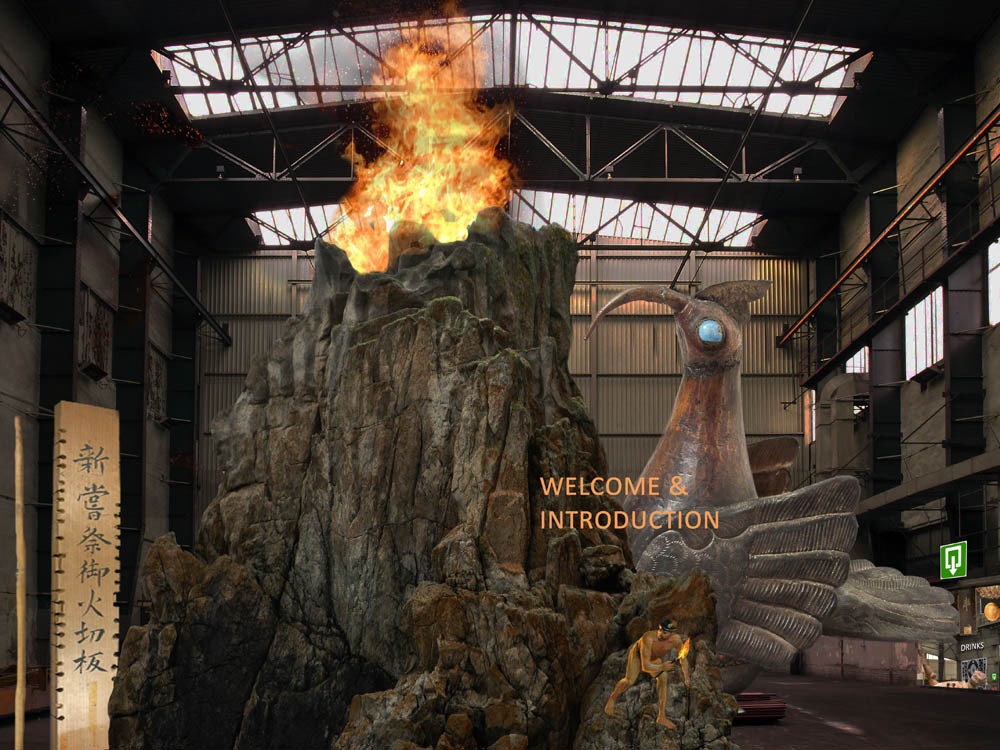



















Prometheus steals the fire from the Gods.
Detail of illustration nr. 3 from the series ‘Prometheus’
Collectors’ cards from Von Liebig Fleisch Extrakt (ca.1930)
FIRE
In the beginning there was no cooking. The primordial soup was solid and the hamburger had to wait for another 4 billion years. When and where it all began remains a mystery. And then, of course, it all depends on what we mean by cooking. Let us keep it simple and state that cooking is preparing food with the aid of fire. Our earliest ancestors did not cook, their diet was raw. It consisted of game, fresh water fish, shellfish collected on the beach, wild plants, small animals and insects. From the moment Homo Erectus (called that way because of its upright posture) discovers how to make fire, he gains a big advantage over his fellow animals. Using fire, he scares predators and captures larger game. He burns forests for crops or life stock and thanks to fire he survives in colder climates. Fire helps him to control his environment and enhance his chances of survival.
Thus fire became a necessity of life. He who used it more aptly had the best chances. Adaptivity and inventiveness started to dominate pure physical powers. Human beings got larger brains and started to cook.
MYTHS
In virtually every culture across the world there are myths concerning the discovery of fire. They all have the same theme: the hero cleverly steals a piece of fire from the gods or other supernatural creatures and brings it to the human world. In Western culture it is the titan Prometheus who succeeds in tricking the Olympian gods and takes fire to humankind down below. Prometheus believed humankind to be badly supplied with useful properties when these were distributed to the creatures of the world. Humans could not fly, they were physically weak, had no fur to protect them and were not able to survive underground or in water. Because of that, human beings were vulnerable. If they possessed the knowledge of fire, their chances of survival would be greatly enhanced. By stealing fire and offering it to humankind, Prometheus simply corrected an ancient mistake.
God-in-chief Zeus was livid about the theft and punished Prometheus by chaining him to a mountain in the Caucasus. Every day an eagle would come and pick a piece of his liver, which would heal again every night. The ordeal was meant to be eternal, but the demigod Heracles finally succeeded to set him free.
Now that fire was in the grasp of man, it was vital to keep it burning. There had to be a place where a permanent fire was kept and protected. Temples were built for the gods of fire who were supposed to guards the fire for humankind. Fire cults developed everywhere in the world, for example with the ancient Celts, Slaves and Germans. Elsewhere Agni was the old Hindu god of fire, Hestia held that position in Greece, Vesta in Rome, and Xiuheuctli in Mexico, to name a few.
Some of these ancient traditions still exist, like with the Hindu in India and with their 140.000 co-patriots, the Parsi. These are the surviving followers of Zoroaster (Zarathustra), the oldest known religious teacher. In Iran, Georgia, Azerbaijan and other regions of the Caucasus one may still find ruins of these old temples of fire.
Linda Roodenburg


PRM Inv. nr. 1892.21.5
‘Sacred fire drill and hearth used in 1879 in the great temple of Izumo,Yashiro, Japan.'
(Shin-o-sai,festival)’
Voltaire Cang: Sacred fire drill and hearth
Every year in May in Japan, the Emperor is shown on national television planting rice seedlings in a paddy field set within the Imperial Palace grounds in Tokyo. The rice is harvested in September, also by the Emperor himself, an event that is again broadcast nationwide. Come November, the first batch of the harvested rice, along with first rice harvests donated by farmers around the country, are offered to the Emperor’s ancestral deities in a ritual called the Niiname-sai , with the Emperor as the main celebrant.
The Niiname-sai is one of the most important events in the Imperial calendar, the one occasion when the Emperor, on behalf of the nation, offers his gratitude to the deities for the harvest as he prays for the welfare of his subjects. The Emperor eats with the deities during the ritual, a commensal act signifying his embodiment of them, especially his main ancestor the ‘Sun Goddess’ Amaterasu , whose benevolence resulted in the good harvest and the continuity of the Imperial line and the nation.
Nii-name-sai (alternately, Shin-jo-sai), reads the first three characters on this hinoki cypress slab; the remaining four tell us its purpose, that is, as a hearth for making sacred fire for the ritual. Basil Hall Chamberlain, the British Japanologist who acquired this piece for the museum, called it a ‘fire-drill’ that he secured ‘from the great Shint temple of Izumo, which the enlightened high priest, Mr. Senke, consented to part with, in order that the learned world of Europe might be able to inspect an example of this most ancient of Japanese religious implements’.
Aside from the Imperial Palace, major Shinto shrines around the country also observe the Niiname-sai, notably the Ise Grand Shrine (dedicated to Amaterasu) and the Izumo Grand Shrine (Japan’s oldest shrine, dedicated to the deity of agriculture and marriage, Okuninushi), the two most important Shinto places of worship in Japan. Since its establishment, Izumo Grand Shrine has been under the administration of the Senge family, also said to have descended from Amaterasu. (Chamberlain’s ‘Senke’ above is an uncommon transcription.). (Recently in 2014, the first son and heir of Izumo Grand Shrine’s chief administrator married one of the current Emperor’s grandnieces, a match that further consolidated ancestral ties.)
In Izumo, the harvest ritual is officially called Koten Shinjo-sai , and formally begins with the delivery of three sets of wooden hearths and drills from Kumano Grand Shrine, not far from Izumo Grand Shrine and known as the birthplace of fire in Japan. Using one of the new sets, shrine attendants light a fire in a hall set expressly for cooking the rice that will be consumed later by the chief officiant in the company of the deities, as the Emperor does in his own ritual. The officiant partakes of the meal, however, only after taking part in a repeated series of offering, prayer, drinking, and dancing rituals. After his meal, he conducts a calligraphy ritual, ceremoniously writing the same characters found in this museum piece onto two of the yet unused wooden hearth slabs. One of these labeled hearths is then brought to the ‘sacred fire place’ to make the fire for cooking the shrine administrator’s meals in the year ahead. The other hearth is sent to another ‘sacred fire place’ annexed to the main shrine hall, to be used in the process of brewing sake for consumption in next year’s ritual. The third, already-used and unlabeled hearth, its mission fulfilled, is carried away with the remainders of the ritual feast to a hidden place in the mountains the next day, broken into pieces and buried in the ground to decompose and be lost forever.


PRM Inv. nr. 1933.52.1
' Fire-Devil ' in the form of a bird, the beak of which forms a fine jet.
Used for blowing up a fire by steam generated inside the vessel.
South Tibet or West Bengal Darjeeling, 1933.




Welcome!
Edible Treasures Unlocked – foodobjects from the Pitt Rivers Museum Collection
Introduction to the exhibition
Objects in European ethnological museums are strongly connected to the colonial and scientific exploration of the non-western world. A great variety of objects was collected and shipped to Europe. In the 19th century Museums were built for the research, conservation and presentation of these objects.
Foodobjects were also considered as important information about cultures especially when they were related to specific rituals.
At the turn of the twentieth century modern anthropology took shape, more and more concentrating on analyzing and interpreting social structures of 'primitive' societies and functional connections between people. With this disengagement from natural sciences, organic and edible objects became irrelevant for ethnological research.
Once considered as valuable objects, but in the course of years downgraded as less relevant things for which the ultimate date of consumption had passed more than a century ago.
That is how they survived.
Without any meddling of museum conservators the contents of the jars and packages fermented, dried, molded or evaporated; a process of slow museum preservation that is still going on.
The Pitt Rivers Museum in Oxford (UK) is a wonderful exception in taking care of its foodobjects as part of its archaeological and ethnological collection. Many of them are still on display with the original handwritten museum labels and inventory numbers as the key to their stories. They refer to researchers and explorers like Beatrice Blackwood, Basil Hall Chamberlain and Katherine Scoresby Routledge.
(The Museum is developing a project named “Labelling Matters” that will scope the problem and suggest forums to mediate and highlight the problematic parts of the Museum's and discipline's history.)
In most ethnological and archaeological museums, objects are arranged according to geographical or cultural areas.
At the Pitt Rivers Museum, they are arranged according to type: musical instruments, weapons, masks, textiles, jewelry and tools are all displayed to show how there are many ways of being, of knowing and of copying.
There are even showcases dedicated to ‘food’.
In this exhibition the FoodMuseum has followed this concept by arranging the objects from the Pitt Rivers'collection as ‘Drinks’, ‘Breads’ (The Bakery), ‘Proteins’, ‘Fruits’ and ‘Medicines & Narcotics’.
There is a lot to tell about these foodobjects from different perspectives. In Oxford every year about two hundred foodresearchers meet at the Oxford Food Symposium. This exhibition connects symposiasts and museumobjects. We invited foodwriters to shed new light on selected foodobjects from the Pitt Rivers Museum collection.
Here you can see and read the results.
-There are six rooms. You are in the first room now, dedicated to the beginning of cooking and civilization: Fire.
-Click on the information buttons to read the available information about the object and articles of the symposiasts. (For leaving the text click on an area next to the text).
-Follow the green signs for going to the next room.
The exhibition ends in the Restaurant which is probably fully booked, but take your time and wander through the museum, visit other exhibitions and rooms as long as you wish.
As you will see, some objects in this exhibition are still ‘locked’: they are waiting for additional information. As a work in progress the project welcomes everyone who likes to add new information, a personal story related to the object or another interesting view.
Interested? Please contact our projectmanager Liz Wilding at: lwilding99@gmail.com.
Colophon
Edible Treaures Unlocked is part of the Oxford Food & Museum Project.
A cooperation between the University of Oxford Museum Collections, the Oxford Food Symposium and the FoodMuseum.
Team:
Linda Roodenburg - Curator of the exhibition and Director FoodMuseum
Liz Wilding – Foodresearcher and Projectmanager
Nicholas Crowe - Asistent curator Pitt Rivers Museum
Contributors to the exhibition and the Pitt Rivers Survival Cookbook:
Gosewijn van Beek (Medicines & Narcotics)
Voltaire Cang (Fire, Breads, Medicines & Narcotics)
Naomi Duguid (recipe Cookbook)
Christine Elliott (Fruits)
Len Fisher (Proteins)
Vicky Hayward (Drinks)
Paul Levy ((Narcotics & Medicines)
Elisabeth Luard (recipe Cookbook)
Allison Reynolds (Breads)
Nanna Rögdvaldordóttir (Breads, Proteins)
Linda Roodenburg (Fire, Medicines & Narcotics)
Or Rosenboim (Drinks)
Helen Saberi (Drinks)
Susan Weingarten (Fruits)
Marcia Zoladz (Breads)
© Texts and images: the authors, photographers, Pitt Rivers Museum, FoodMuseum
© Concept and exhibition design: FoodMuseum/Linda Roodenburg
No part of this exhibition may be used or reproduced without the permission of the copyright holders.




